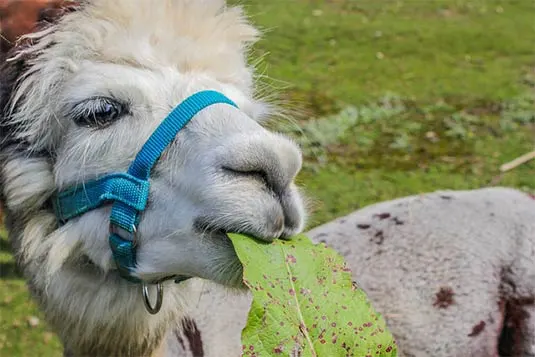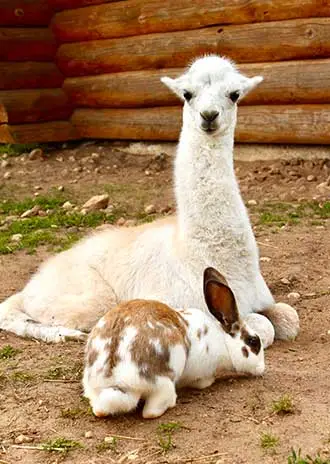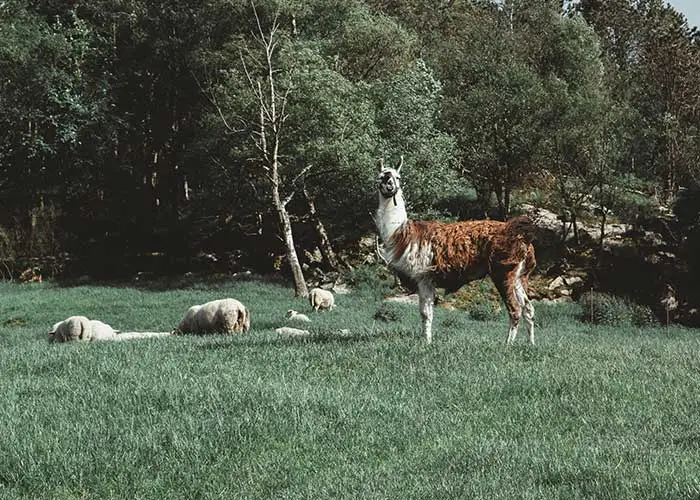For many years, farm owners have stopped using guns to protect their livestock from different predators. Instead of firearms, owners switched to using llamas.
A prey animal like a coyote might attack their calves, chickens, goats, sheep, etc.
So why use llamas?
Llamas are natural herd protectors with a personal vendetta against the coyotes. If they get into contact with one, they will sound an alarm and try to chase away the invasive predator.
And in some cases, a llama will stomp its enemy to death.
This is, of course, a llama being protective of the herd it is guarding.
But what about hunting down and attacking other animals for food? Does a llama prey on other animals?

Table of Contents
What Animals Does A Llama Prey And Eat?
A llama is not a natural predator and does not prey on other animals. Llamas have razor-sharp canine teeth that can be lethal against other animals, but they mostly use them to fight among themselves.
Farmers that use llamas for herd protection report that in many instances, when a coyote preys on their livestock that is grazing on the field, a llama will give its best to protect the herd.
Look how two llamas chase away a coyote from their farm.
After they spot the predator, llamas will first sound an alarm, a strong scream to warn the others so they run away.
Llamas will then charge at the invader, spit, bite, kick, and in many times kill it.
But after killing the preying animal, will a llama eat it?
Are Llamas Carnivorous?
No, llamas are not carnivorous. They will not prey on other animals, hunt them for their flesh and then eat them.
Llamas are herbivores; they eat plant-based diets and no meat. They are both grazers and browsers.

This means that they eat both the grass and other low-growing vegetation, together with high-growing plants such as leaves, the bark of trees, and shrubs. Llamas have a stomach with three chambers that allows them to digest many nutrient-poor foods.
A llama’s distant cousin, the camel (yes, camels and llamas are related), will mostly feed on plants, just like a llama. However, if a camel does not find food for a long time, and stumbles upon a carcass in the desert, it might consume its meat, bones, or skin.
It is important to note that, neither camels nor llamas prey on animals.
What Animals Prey On Llamas?

The animals that prey on llamas the most are domestic dogs, followed by coyotes, mountain lions, bears, and wolves in some regions.
Dogs are present in almost all areas with livestock. The more animals on the farm are, the higher the chance of a dog attack. They will chase or molest llamas and other livestock “for fun,” and probably return for more.
The main reason why dangerous dogs or packs of dogs prey on llamas is to kill. They will mostly attack younger llamas and will not consume a lot of their flesh as in most cases they will not be hungry.
Wild dogs will inflict most wounds on the neck, often to multiple victims.
Coyotes live in both rural and urban areas. They will mostly attack during the night. Usually, a coyote will kill a single llama, except in periods of the year when the young coyotes are learning to hunt.
After preying successfully on a llama, they will consume parts of larger stock on the spot. If they killed a smaller animal, they will try to drag it away. Llamas are a bit slower than coyotes, which occasionally gives them some chance to outrun them.
Mountain lions (cougars, or pumas) are also a potential predator problem in areas with llamas and other livestock. They usually hunt at night and will inflict lethal wounds in the neck, body, flanks, or thighs.
They will drag smaller animals to trees of other sheltered locations to eat them.
Wolves, black bears, grizzly bears, foxes, and eagles have occasionally hunted llamas and other South American camelids for food. These are all ferocious predators that attack both day and night.
Further reading: Why llamas bite off other llamas’ genitals
Why Don’t Llamas Prey On Other Animals?
Llamas have extremely sharp canine teeth, a strong jaw, and deadly kicks. Their canine teeth are curved and capable of inflicting deadly wounds. This makes llamas well-equipped to eat meat. And yet, they don’t eat it.
The reason is in their digestive system.
Llamas don’t prey on animals, kill them, and then eat their flesh because it is not their primary food group and because they wouldn’t receive too many nutritional benefits from it. Also, switching to an all-meat diet could be potentially deadly for the animal.
Llamas do not have well-suited enzymes to break down such food and properly absorb vitamins and minerals.
Final Thoughts

This concludes our article talking about llama being prey or a predator.
Llamas are herbivores, they do not prey on other animals, nor hunt them for food. They have sharp canine teeth they might use to prey on and kill other livestock, but they do not do it. The main predators of llamas are wild dogs, coyotes, foxes, pumas, cougars, and occasionally bears and wolves.
References
[1] Cebra, Chris, et al. Llama and alpaca care. Elsevier Health Sciences, 2014.
